Ryan Hall's Blog, page 213
October 4, 2016
Legendary Run: Jim Walmsley Crushes Grand Canyon Rim-to-Rim-to-Rim Running Record
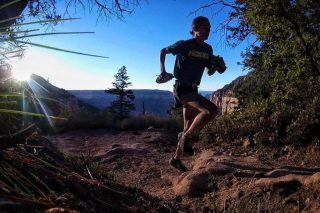
Jim Walmsley approaches the North Rim of the Grand Canyon early on Oct. 4, about half way to what would eventually be a new R2R2R running record. Photo: Kelly Halpin
In what might be one of the world’s greatest running records ever set, Jim Walmsley broke the Grand Canyon Rim-to-Rim-to-Rim trail running record on Oct. 4 by completing the 42-mile roundtrip in an astonishing 5 hours, 55 minutes and 20 seconds.
While it’s impossible to compare that to other eye-popping records such as Dennis Kimeto’s 2:02:57 world record in the marathon or David Rudisha’s 1:40.91 effort in the 800-meter run, Walmsley’s remarkable run certainly belongs in the same conversation—at least given by how much and how dramatically the record was broken. He took 26 minutes off of the previous Fastest Known Time set by Rob Krar (6:21:47) in 2013. That means he averaged 8:27 per mile over a trail route that includes more than 24,000 feet of vertical change, including a 5,000-foot ascent over the final 7 miles to the finish at the South Rim.
The 26-year-old Walmsley, who grew up in Scottsdale, Ariz., and ran collegiately for the U.S. Air Force Academy, also broke Krar’s Rim to Rim record running south to north on the first part of his roundtrip. After starting from the South Rim at 4:27 a.m., he covered that section in 2:46, roughly 5 minutes ahead of Krar’s 2:51:28 mark from 2012. That’s about 7:54 mile pace on terrain that includes a massive, 4,000-foot climb to the North Rim.
Walmsley’s mile pace might seem slow to seasoned road or track runners, but they’re quite fast for running on trails—especially when you consider the difference between his downhill and uphill mile paces. His Strava data shows that he was flying on the downhill section off the South Rim, averaging about 6:20 mile pace for the first 13 miles, including a 5:22 mile from mile 9 to 10. In all, he recorded 17 mile splits under 7:00 and he ran 25 of the 42 miles in 7:59 or faster. (See Jim Walmsley’s Strava data here.) Walmsley’s uphill mile pace was in the 10:00-13:20 range, with two mile splits of 17:33 and 17:02 on this final ascent back to the South Rim.
Those are amazing numbers, for sure, but to those who have run across the Grand Canyon and back at any pace, they’re astounding.
“That’s freaking crazy,” said Dave Mackey, who was the first runner to break 7 hours running the Rim to Rim to Rim route in 2007. “It’s an amazing record. Can you imagine what he can do in some of the 100-mile races? I thought Krar was setting the bar pretty high, but Walmsley has set it even higher.”
The Grand CanyonRim-to-Rim-to-Rim run is a bucket-list item for many ultrarunners, but it’s also one of the world’s top tasks in the Fastest Known Time universe. But running across the Grand Canyon and back is grueling for anyone who attempts it, both because it badly beats your legs up on the long steep downhills and crushes everything else on the monstrous uphills. At 42-miles long and just around 24,600 feet of elevation change, the grandiose route is a scenic masterpiece showcasing the vast and diverse geology that comprises the Kaibab Plateau. From the South Rim to the North Rim and back, the iconic line is brutally beautiful and sits revered by all runners who have ever dropped inside the Canyon’s walls.
Walmsley dressed to run light and fast, wearing a moisture-wicking short-sleeved T-shirt, running shorts and a pair of Hoka One One Challenger ATR 2 trail running shoes, while carrying two hand-held 20-ounce water bottles (which he re-filled at water spigots along the way).
RELATED: You Can Do It: A Runner’s Guide to Conquering the Grand Canyon
Krar was among the first to congratulate Walmsley once he got word of the new record, tweeting out: “Congrats to @walmsley172 on setting a new Grand Canyon R2R2R FKT in an unbelievable 5:55:20, and R2R FKT in the process!”
Although Allyn Cureton’s 1981 Rim to Rim to Rim record (7:51:23) record lasted for 25 years, it has now been broken five times in 10 years. Kyle Skaggs (7:37, 2006), Dave Mackey (6:59:56, 2007), Dakota Jones (6:53:38, 2011) and Krar (6:21:47, 2013) turned in great performances, but Walmsley’s effort is of a different magnitude. Cureton also set the one-way record in 1981 (3:06:47, running North to South via North Kaibab and South Kaibab) but Krar took that down in May 2012 with his 2:51:28 effort, only to have Walmsley smoke that one too.
(In case you’re wondering, the women’s R2R2R record is 8:15:51, set by Bethany Lewis in 2011. The double Rim to Rim to Rim record is 43:31:00, set by Jason Vaughn in 2013. Vaughn’s mark was set en route to becoming the only person ever to complete a triple Rim to Rim to Rim undertaking, doing so in a mind- and leg-numbing 43:31:00.)
RELATED: Maps, Stats and More Details of The Grand Canyon R2R2R Route
After a solid high school running career (including a 23rd-place finish at the Foot Locker Cross Country National Championships in 2007), Walmsley was a good college track runner at Air Force from 2007-2012, with PRs of 13:52 for the 5,000m and 29:08 for 10,000m. Those times might suggest he could run a fast half marathon or marathon, but his best half marathon is 1:08:08 and he’s never run a marathon on the roads. But since moving up from shorter distances in 2014, including the JFK 50-miler in Washington D.C. in 2014 and the Lake Sonoma 50 in Healdsburg, Calif., this past April.
Walmsley has seemed to have found his niche in ultrarunning, but not without a few dramatic blow-ups. At the 2015 IAU 100K World Championships in the Netherlands, Walmsley took off crazy fast from the start and built a 5-minute margin on the rest of the field, leading through the 50K mark in 3:05:20 (5:57 mile pace). But he would eventually blow up badly and retire from that race after about 70K. He was on record-setting pace at the Western States 100 in late June, only to go off course near mile 90 and lose more than 45 minutes trying to find his way back. He backtracked and eventually finished in 20th place, but it left a lot of runners wondering what might have been.
From the moment Walmsley set his sights on the Grand Canyon record a year ago, he never doubted his ability to achieve the unthinkable.
“This one is for Arizona, my friends, and my family who have supported me from day one,” Walmsley said moments after he emerged from the South Rim.
On Tuesday, the torch was passed. A new King of the Canyon has been crowned, and his name is Jim Walmsley.
RELATED: Taking the Challenge of Running the Grand Canyon Rim to Rim to Rim
RELATED: Do Something Epic: Test Yourself on an Unsupported Trail Running Adventure
The post Legendary Run: Jim Walmsley Crushes Grand Canyon Rim-to-Rim-to-Rim Running Record appeared first on Competitor.com.
Jim Walmsley Shatters Grand Canyon Rim-to-Rim-to-Rim Running Record

Jim Walmsley approaches the North Rim of the Grand Canyon early on Oct. 4, about half way to what would eventually be a new R2R2R running record. Photo: Kelly Halpin
Jim Walmsley set a new Grand Canyon Rim-to-Rim-to-Rim trail running record on Oct. 4, completing the 42-mile roundtrip in 5:55:20.
He shattered the previous Fastest Known Time set by Rob Krar (6:21:47) in 2013. That means he averaged 8:27 per mile over a trail route that includes more than 20,000 feet of vertical change, including a 5,000-foot ascent over the final 7 miles to the finish at the South Rim.
The 26-year-old Walmsley, who ran collegiately for the Air Force Academy, also broke Krar’s Rim to Rim record running south to north on the first part of his roundtrip. He covered the course in 2:45, roughly 6 minutes ahead of Krar’s 2:51:28 mark from 2012.
The Grand CanyonRim-to-Rim-to-Rim run is a bucket-list item for many ultrarunners, but it’s also one of the world’s top tasks in the Fastest Known Time universe. At 42-miles long and just around 20,000 feet of elevation change, the grandiose route is a scenic masterpiece showcasing the vast and diverse geology that comprises the Kaibab Plateau. From the South Rim to the North Rim and back, the iconic line is brutally beautiful and sits revered by all runners who have ever dropped inside the Canyon’s walls.
RELATED: You Can Do It: A Runner’s Guide to Conquering the Grand Canyon
Walmsley was on record-setting pace at the Western States 100 in late June, only to go off course near mile 90 and losing more than 45 minutes. He backtracked and eventually finished in 20th place, but it left a lot of runners wondering what might have been.
From the moment Walmsley set his sights on the Canyon record a year ago, he never doubted his ability to achieve the unthinkable.
“This one is for Arizona, my friends, and my family who have supported me from day one,” Walmsley said moments after he emerged from the South Rim.
Today the torch has passed. A new King of the Canyon has been crowned and his name is Jim Walmsley.
RELATED: Taking the Challenge of Running the Grand Canyon Rim to Rim to Rim
The post Jim Walmsley Shatters Grand Canyon Rim-to-Rim-to-Rim Running Record appeared first on Competitor.com.
October 3, 2016
6 Places You Should Never Carry a Phone When Running
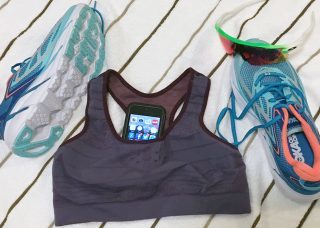
A sports bra was meant for carrying things on the run, but not your phone. Photo: PK Simich
These days, most people have separation anxiety when it comes to their phones. Frightened to death that they might miss a “like” on Instagram or a text from some random acquaintance, many people (sadly) cannot even take a short run without their device. Sure, having your phone with you while running is a good safety measure to take, and it is a lifeline if you wimp-out and need a ride home. However, it’s crucial to be careful and smart about how you store your phone on your person while running.
Never carry your phone in any of the following places. If you’ve done it, you’ll know what I’m talking about. If you haven’t, well, just don’t do it.
1. In your sports bra.
While the sports bra might seem like the ideal place to hold a phone for ladies, it’s inadvisable. Inevitably, the phone will become so immersed in one’s cleavage that it can be lost or worst yet, waterlogged with breast sweat. Moreover, if you try to put the phone atop one of your breasts, then you run the risk of chafing and being exceedingly lopsided.
2. Down your pants.
You may think you can wedge your phone in the elastic part of your tights/shorts that goes around your waist. Chances are, however, that gravity will work its magic and the phone will soon end up taking a journey down your lower abdomen and into your crotch area where it will become tainted with God only knows what.
3. In your hand.
It’s true that people actually run full marathons carrying a phone in their hand. I’ve seen it happen. The advantage to this is that the phone is at the ready for that impromptu selfie or picture of your favorite running partner throwing up or copping a squat. Yet, as your hand becomes moist with sweat, the phone will likely slip out of your grip and crash onto the hot asphalt. Don’t risk it.
4. Taped to your inner thigh.
Everyone knows that one of the best uses for duct tape is for attaching your phone to your inner thigh, right? Wrong. Why is this not a good idea? Mostly, because you will rip off hair from one of the most sensitive places on your body when you try to remove the phone. Also, your phone will likely rub against the other leg, causing some wicked chafing.
5. In your shoe.
Running involves taking about 2,000 steps per mile. Putting your phone in your shoe and thinking it will not break is like putting yourself in a race with Kara Goucher and thinking you will win. It is just not possible.
6. In your compression sock, right around the calf area.
The point of compression socks is that they squeeze the lower leg to increase blood flow. While positioning your phone in your sock might guarantee it stays put, it will also likely leave a permanent phone imprint on the tender skin of your leg.
The moral of the story: If you really cannot run without your phone, then put it in an armband, waist belt, fuel belt or hydration pack. You and your phone will be much happier this way.
RELATED: How to Beat 6 Common Excuses for Not Running
The post 6 Places You Should Never Carry a Phone When Running appeared first on Competitor.com.
6 Places You Should Never Carry a Phone When You Run

A sports bra was meant for carrying things on the run, but not your phone. Photo: PK Simich
These days, most people have separation anxiety when it comes to their phones. Frightened to death that they might miss a “like” on Instagram or a text from some random acquaintance, many people (sadly) cannot even take a short run without their device. Sure, having your phone with you while running is a good safety measure to take, and it is a lifeline if you wimp-out and need a ride home. However, it’s crucial to be careful and smart about how you store your phone on your person while running.
Never carry your phone in any of the following places. If you’ve done it, you’ll know what I’m talking about. If you haven’t, well, just don’t do it.
In your sports bra. While the sports bra might seem like the ideal place to hold your phone, it’s inadvisable. Inevitably, the phone will become so immersed in one’s cleavage that it can be lost or worst yet, waterlogged with breast juice. Moreover, if you try to put the phone atop one of your breasts, then you run the risk of chafing and being exceedingly lopsided.
Down your pants. You may think you can wedge your phone in the elastic part of your tights/shorts that goes around your waist. Chances are, however, that gravity will work its magic and the phone will soon end up taking a journey down your lower abdomen and into your crotch area where it will become tainted (
In your hand. It’s true that people actually run full marathons carrying a phone in their hand. I’ve seen it happen. The advantage to this is that the phone is at the ready for that impromptu selfie or picture of your favorite running partner throwing up or copping a squat. Yet, as your hand becomes moist with sweat, the phone will likely slip out of your grip and crash onto the hot asphalt. Don’t chance it.
Taped to your inner thigh. Everyone knows that one of the best uses for duct tape is for attaching your phone to your inner thigh. Why is this not a good idea? Mostly because you will rip off hair from one of the most sensitive places on your body when you try to remove the phone. Also, your phone will likely rub against the other leg, causing some wicked chafing.
In your shoe. Running involves taking about 2,000 steps per mile. Putting your phone in your shoe and thinking it will not break is like putting yourself in a race with Kara Goucher and thinking you will win. It is just not possible.
In your compression sock, right around the calf area. The point of compression socks is that they squeeze the lower leg to increase blood flow. While positioning your phone in your sock might guarantee it stays put, it will also likely leave a permanent phone imprint on the tender skin of your leg.
The moral of the story: If you really cannot run without your phone, then put it in an armband, waist belt, fuel belt or hydration pack. You and your phone will be much happier this way.
RELATED: How to Beat 6 Common Excuses for Not Running
The post 6 Places You Should Never Carry a Phone When You Run appeared first on Competitor.com.
6 Ways to Become a Faster Runner Without Running a Step
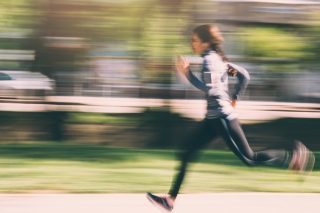
There are plenty of things you can do to get faster without running a step. Photo: iStock
Runners are a hardworking lot, so the promise of “free speed” often strikes us as empty, and maybe even a touch offensive. However, once you get runners talking about improvements they have made in their training, gear or diets, they are usually eager to share the discoveries that have helped improve their performances. That’s the goal with this article—to share some well-documented techniques that could help you get faster, beyond than the obvious (and undeniably effective) advice to run more miles and train harder.
Wear Lighter Shoes
Researchers have established that the reducing shoe weight by 100 grams typically yields about a 1 percent increase in performance. That’s a pretty big gain that could be especially noticeable over longer distances. However, like most of the tips in this guide, there are some limitations to keep in mind—not every runner will benefit from switching to racing flats or other super-light shoe models. If the cushioning or shoe stability is inadequate you will lose efficiency and give back any potential performance gains.
RELATED: Are Racing Flats Right for You?
Get a Proper Warm-up
“Ninety percent of success in running comes down to a willingness to work hard and sacrifice, and being consistent,” Coach Alan Culpepper recently wrote. “The other 10 percent comes down to areas like diet, hydration, stretching and injury prevention. A proper pre-run warmup routine is part of that 10 percent. It might seem inconsequential, but it can make or break a race or hard workout.” Read Coach Culpepper’s warmup advice here, and check out the link below for info on a dynamic warmup that researchers say can improve performances.
RELATED: The Mattock Dynamic Warm-up for Runners
Lose Unwanted Bodyweight
Like our first tip about the potential speed gains from reducing shoe weight, it’s proven that reducing excess bodyweight can help make runners faster—but only to a point. “Each runner has an optimal racing weight,” writes Matt Fitzgerald, the author of Racing Weight, How to Get Lean for Peak Performance. “I define this as the weight at which a runner performs best in races. Because runners are more often above their optimal racing weight than right at it, they tend to associate losing weight with gaining performance. This association leads some runners to make weight loss their primary focus and to push performance into the background.” Simply put, losing a few pounds could make you faster, but losing too much weight will make you slower, and potentially lead to other health issues.
RELATED: For Runners, Not All Weight Loss is Good Weight Loss
Add Plyometric Exercises
We said we could make you faster without running more, but we didn’t say anything about adding leaping, bounding and jumping to your training. Multiple studies have shown that adding plyometric exercises to runners’ normal routines produces gains in both speed and endurance. The speed part makes sense intuitively—the explosive nature of plyometrics clearly translates to better top-end running speed. But keep in mind that as your explosive power increases your running economy and endurance usually improves too.
RELATED: The Benefits of Plyometrics for Runners
Crank Up the Tunes
Another point that running researchers agree on is that there is a sweet spot of about 180 steps per minute that most elite runners meet or even exceed. A faster cadence leads to better efficiency and reduces the chance that you are overstriding. So, how do you boost your running cadence toward this mark? Try making playlist with songs like the 15 tunes featured in the article below—they will pace your footsteps with 180 beat-per-minute rhythms.
RELATED: How Music Can Boost Your Cadence
Stop Running
Perhaps you clicked on this story because you’re feeling a bit desperate to get faster. You’re hitting your target mileage, and sometimes more, every week. You give your all in speed work and other demanding training sessions, but without seeing the results you’re hoping to achieve. If those scenarios sound familiar you are a prime candidate for becoming overtrained. “While the signs and symptoms of overtraining aren’t overt, it is possible to identify which activities present the greatest danger to overtraining, recognize subtle signs that suggest you’re approaching the precipice, and discuss how to come back if you believe you are overtrained,” writes running coach and author Jeff Gaudette in the article below.
RELATED: Overtraining: Why It Happens, How To Spot It and How To Dig Yourself Out
The post 6 Ways to Become a Faster Runner Without Running a Step appeared first on Competitor.com.
10 Amazing Benefits of Running You Might Not Have Known
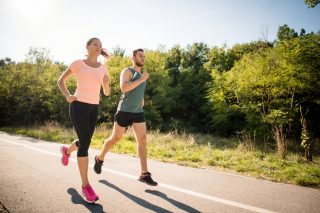
There are numerous benefits of running other than just improving your fitness. Photo: iStock
If you are a runner, you know that running has changed your life. It’s not just an activity or exercise, it’s a way of life. While the benefits are numerous, that doesn’t mean running has changed everything. We are still human after all.
Overall mental health.
Runners are happy people. We’ve got that runner high thing going for us. Just don’t make us unhappy by canceling a race that we’ve trained months and months for. That’s one way to turn a runner’s smile upside down.
Strengthens your lungs.
Runners have increased lung capacity from logging mile after mile. Those strong lungs come in handy if you ever find yourself on the other side of race as a spectator. A runner’s WOOHOO! is loud and proud.
Helps prevent high blood pressure.
Your arteries expand and contract while running helping to keep your arteries fit which in turn keeps your blood pressure in a normal range. That is until you find out that your favorite running shoe has been discontinued. Nothing is harder to replace than a beloved running shoe!
Strengthens immune system.
Regular running builds up your tolerance to germs which results in fewer minor illnesses. That is unless you are training for a marathon. Then you will be sick all the time.
Weight control.
Running burns mega-calories. However, it makes you mega-hungry, especially if you are training for long distances. Running doesn’t give you a pass to eat all the food, all the time.
Physically strong legs.
Runner’s legs are a powerhouse. They move you from point A to B. They carry you up and down hills. They know how to put it into high gear at the track. They also will have a hard time fitting into skinny jeans when you are in the thick of marathon training.
Relieves stress.
Running boasts the brain’s serotonin levels which make you calmer and more relaxed. Who said you can’t run away from your problems?
Increased bone density.
Running stresses your bones. Essential minerals are sent to the bones when under stress, which makes them stronger. However, running does not make you unbreakable. You still can break a bone by thinking you can jump a 10-foot high fence.
Increased joint strength and stability.
Running increases the strength of your ligaments and tendons. You’ll find your joints will be able to withstand more mileage and more uneven terrain. But that doesn’t mean you will never sprain your ankle again while trail running. It just may mean four weeks on crutches versus eight weeks if you didn’t run.
Increased confidence. Once you start running, your confidence begins to grow. You’ll feel more in control of your life and your body. You will even begin to think you look good in spandex tights.
RELATED: 6 Ways to Become a Faster Runner Without Running
The post 10 Amazing Benefits of Running You Might Not Have Known appeared first on Competitor.com.
October 2, 2016
A Celebration for Olympic Bronze Medalists Jenny Simpson and Emma Coburn

On Sept 30, Competitor helped honor Olympic bronze medalists Jenny Simpson and Emma Coburn at a party at the Flatirons Running/New Balance Run Hub store in Boulder, Colo. Coburn, 25, earned the bronze in the 3,000-meter steeplechase, while Simpson, 30, earned her bronze in the 1,500-meter run. Both are former University of Colorado standouts who are sponsored by New Balance and still train in Boulder under coaches Mark Wetmore and Heather Burroughs. After Boulder mayor Suzanne Jones read a proclamation to honor all five of Boulder’s 2016 Olympians, fans, friends and local runners watched video replays of the women’s 1500m and steeplechase races while Simpson and Coburn offered up interesting commentary. Check out the scenes from the party below.
Photo Gallery
1 of {count}
Back to Start
View Larger Image
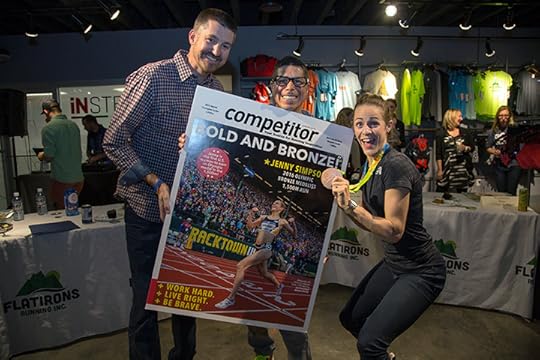
Jenny poses with a special edition of Competitor along with New Balance National Sales Manager Kevin Adams and Flatirons Running co-owner Henry Guzman. Photo: Glen Delman
View Larger Image
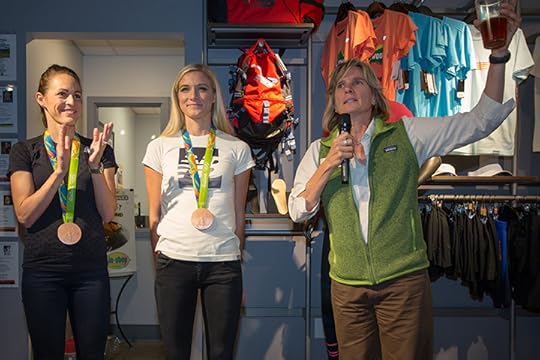
Boulder mayor Suzanne Jones honors the work ethic and courage of Simpson and Coburn. Photo: Glen Delman
View Larger Image

Simpson said training in Boulder was a big part of their success. Photo: Glen Delman
View Larger Image

Coburn lauded Simpson's friendship and mentoring to help her achieve the highest level of success in the steeplechase—an event Simpson used to run. Coburn now owns the American record in the event, slicing 5 seconds off the mark that Simpson once held. Photo: Glen Delman
View Larger Image
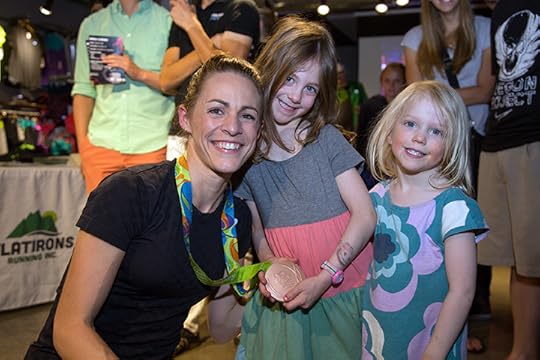
Photo: Glen Delman
View Larger Image

Photo: Glen Delman
View Larger Image

Photo: Glen Delman
View Larger Image
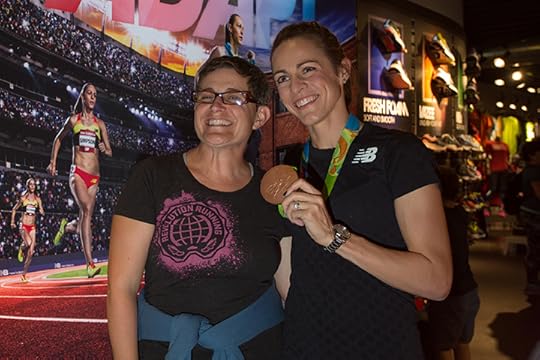
Photo: Glen Delman
View Larger Image

Photo: Glen Delman
View Larger Image

Photo: Glen Delman
View Larger Image
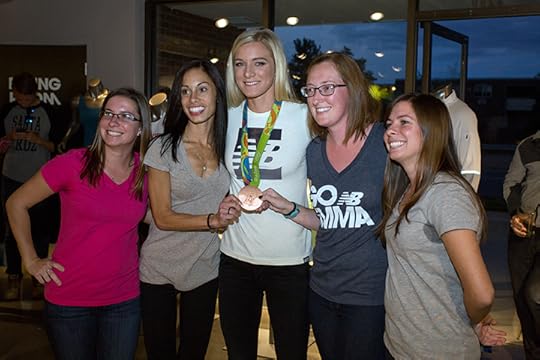
Photo: Glen Delman
View Larger Image
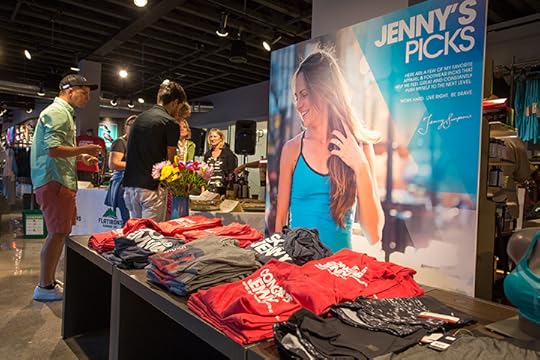
Photo: Glen Delman
View Larger Image
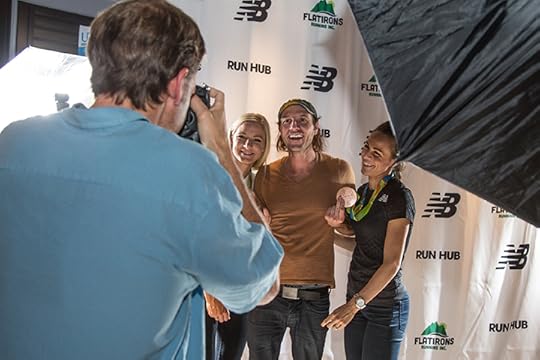
Photo: Glen Delman

More Galleries
The post A Celebration for Olympic Bronze Medalists Jenny Simpson and Emma Coburn appeared first on Competitor.com.
Beer & Running: Serving Up Running Shoes and Fresh Microbrews
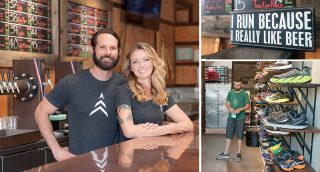
Paul and Renne Rakitin re-opened their running store as The Running Shop and Hops in August. Photos: Jason Weed and Brian Metzler
A glance at the first two U.S. running shops that sell running gear and serve beer, too
Paul Rakitin has been a committed runner and an aficionado of good beer as long as he can remember. He started running in grade school and has never stopped, running just about every distance and qualifying for the Boston Marathon.
He’d worked in and managed a few running stores and got the itch to own his own shop. After finishing up a tour in Afghanistan as an Army medic a few years ago, he went into business for himself, with the notion that he’d like to be able to serve up both of his passions. He opened The Running Shop in July 2013 purely to get into the specialty running retail business, but he always had the urge to serve beer too. So not long after he got wind of Shoes & Brews opening in Colorado, he decided to take the next steps.
This past summer, Paul and his wife, Rene, relocated the running store to a refurbished, 3,000-square-foot location in downtown Morgan Hill and reopened with a new section of the business—a taproom that serves up 54 different beers (including four with nitro taps). They changed the name to The Running Shop and Hops, and, since opening in mid-August, both sides of the business have been booming.
“I had been thinking about this idea for about six years, but I didn’t have the funding to get it off the ground back then,” says Rakitin, 39, who has been running for almost 30 years. “I approached a handful of people early on and a lot of them looked at me like I was crazy, but to me it was a natural progression of what running has become and a natural synergy between the two types of the business.”
PHOTOS: A Glimpse Inside The Running Shop and Hops in Morgan Hill, Calif.
Sound crazy? Not really. As running has grown and changed, more and more participants are identifying with a fitness lifestyle more than the competitive or performance-oriented principles that emanated from the 1970s and 1980s. Studies have shown that traditional race participation has dropped since 2013, especially in the 18-24 and 25-34 age groups. At same time, novelty runs, obstacle racing and running events that include beer have been soaring.
In mid-September, The Brew Hop 5K drew several thousand people to Randall’s Island Park in New York City for a 3.1-mile race at noon, followed by a four-hour beer festival that included 15 regional microbreweries. The Beer Relay—a running and beer-drinking relay—debuted in 2015 with events in Colorado and North Carolina and added a third event in Texas this year.
The intersection of beer and running has gained a lot of notoriety in the past year or so as the line between fitness activities and post-workout beverage consumption has become significantly blurred.
“It’s part of the social aspect of being active,” says Sharon Cutler, managing director of Adventure Fit Inc., which produces The Beer Relay events. “It’s all about camaraderie and community. When you go for a run with your buddies, you want to go hang out and have a beer with them too. It used to be people were doing it on their own—and they still are—but now there are events and communities built around it.”
VIDEO: How to Drink and Dash at The Beer Relay
The two sides of The Running Shop and Hops are separated by an 8-foot by 12-foot door, but the connection is rather seamless. Runners can visit the retail shop without being overwhelmed by the taproom and vice versa. The business has a beer-only liquor license and it serves snacks, but customers are allowed (and encouraged) to have food delivered from local restaurants. Combined with a large patio and a kids’ play area with games, it’s become a popular place for families with young children.
“It’s been cool to see so many families come in,” Paul says. “It’s difficult to find places that are truly kid-friendly and not feel awkward about bringing your child to a craft beer room. We have a different environment than a standard tavern, but that’s exactly what my wife and I wanted to create as a business and for the town and I think it’s been well-received.”
In addition to its Tuesday morning track workouts, the store has also organized and sponsored a few races. But the biggest splash has been made around its weekly Beer Run—a 4½-mile social fun run held every Thursday night. When runners return from the easy jog, a low-key gathering morphs into a casual, extended happy hour with beer specials and meals from food trucks.
“It definitely brings more people together,” says Zachary Abrams, one of the running store managers and a Boston Marathon qualifier. “It’s a good way to get together after a run, no matter if it’s a hard workout or an easy run. It doesn’t really matter what kind of runner you are, it’s more about hanging out. There are a lot of people who come in who are really into local breweries and craft beer.”
That’s exactly what inspired four runners in Colorado to open up Shoes & Brews in 2014 as the first full-fledged beer and running operation in the U.S. On one side of the building, it’s a full-service running store with an artfully designed shoe wall and all the apparel, accessories and nutritional items you’d find at any running shop. But this store also has 20 microbrew taps that pour good beer from the best breweries along Colorado’s Front Range. In what should come as no surprise, it was started by a group of enterprising young runners (including three former track and cross country teammates at Colorado State University) who have a hankering for craft beer.
“I think it’s all about relaxing and spending time with your friends and the people you run with,” says co-founder Colin Anderson, 26, who pitched the idea to numerous friends and potential investors, including his dad, Roger, 53, who helped get it started. “In college, after a track meet, we’d all get together and have a beer and celebrate, and that’s something all runners like to do.”
VIDEO: Colorado’s Shoes & Brews Running Store
Technically, Shoes & Brews running store and bar are separate operations (physically and financially), but they’re under the same roof and share a logo. The two sides of the business are connected by a door in the middle of a short hallway, but runners and beer drinkers can visit either side freely.
Shoes & Brews hosts popular weekly fun runs on Thursday nights and it has hosted a few 5K races that start at the nearby Left Hand Brewing Company and finish at the store. Then there is the Run for Beer 800m Road Challenge, in which you determine the price of your first pint of beer by the time you run. For example, if you can run 3:30 for that half mile, you pay $3.30 for your beer. The fastest time (and least expensive) beer on record? That belongs for 2008 U.S. Olympian Billy Nelson, who ran a 1:57.10 and paid just $1.57 for his beer. (He jokes that if he’d run 3 seconds slower, it would have cost him 43 cents more for the beer!)
Shoes & Brews has a liquor license that allows it to both serve and brew beer. Although it started brewing on a very small scale in 2014, head brewer and co-founder Roger Anderson has been fine-tuning his recipes and manufacturing process and now the store produces just under 100 barrels per year. Its most popular beers are the Hef-Yeah! (a traditional unfiltered Hefeweizen) and the Negative Split IPA (an India Pale Ale flavored with Colorado-grown Cascade and Chinook hops).
“Shoes and Brews is a business built on two passions coming together,” says co-founder Ashlee Anderson, 30, Colin’s wife “We just wanted to create a social environment where you could do both in the same place.”
Are these running stores brewing up beer drinkers? Not hardly.
“It’s definitely a lot more about the social aspect and having a place where people come and talk about running,” Rakitin says. “A good running store with a social element is where people can talk about injuries, injury prevention, how they should be training. People ask us questions because we’re seasoned runners, but it’s because it’s a place they like to hang out.”
RELATED: Running the NYC Marathon 5 Boroughs, 5 Beers Style
The post Beer & Running: Serving Up Running Shoes and Fresh Microbrews appeared first on Competitor.com.
American Biwott Wins Rock ‘n’ Roll San Jose Half Marathon
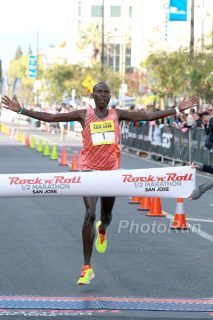
American Shadrack Biwott wins the Rock 'n' Roll San Jose Half Marathon on Oct. 2. Photo: PhotoRun.net
After Sunday’s incredible finish at the annual Rock ‘n’ Roll San Jose Half Marathon, there was no doubt whatsoever that success there runs in the family. Shadrack Biwott, brother of former champion and current course-record holder Duncan Kibet, won the 13.1-mile race. The 31-year-old blazed the scenic and super-fast course in downtown San Jose in one hour, 1 minute and 55 seconds.
Biwott, a U.S. citizen and former University of Oregon All-American, is currently training in Mammoth Lakes Calif., under the watchful eye of Andrew Kastor of the Mammoth Track Club.
“I felt amazing,” Biwott said afterwards. “I honestly didn’t know the pace I was running at the beginning. My first mile was 4:41 and I said that I might as well keep running like this if I can.” Biwott says he saw his coach out on the course and he offered some encouragement. “He said, ‘Shaddy,you look good. Use your arms. Look up. Have fun,’.”
PHOTOS: 2016 Rock ‘n’ Roll San Jose Half Marathon
Biwott made his move at mile 5 when he dropped eventual-second-place finisher Patrick Smyth.
“I felt great. Once I saw the [lead] truck. I chased it down. I kind of fell asleep around miles 10, 11, and 12, but then I woke up and told myself to push it.”
Sunday’s race was a tune-up for Biwott before the New York City Marathon next month. “Today’s race tells me I’m on the right track for it. I have another 4 weeks for hard training then I’m going to taper and see how it goes.” Biwott says he won’t race any more before New York. “Today’s effort felt easy for me. I’m very happy with the race.”
Second-place finisher Smyth clocked 1:03:21, while Daniel Tapia of Mammoth Lakes was third in 1:04:13
The women’s half-marathon was also a similar race with a dominant winner. Kenya’s Sally Kipyego crossed the finish line first in the heart of San Jose with a 1:09: 53 showing.
“It was a good day. The conditions were perfect,” she said. Like Biwott, Kipyego stuck with a pack that included rival Sara Hall until mile 5 “I just ran the last 8 miles by myself. That was a bit difficult.” Kipyego admitted afterward that she went into the race with tired legs to see how she felt. “I was pleased with that,” she said. “Going under 1:10 was good.” Kipyego, who trains in Flagstaff, Arizona, will be racing the New York City. “This race tells me that I’m strong,” she said. “I think I can run faster.” For New York, she says she just wants to be competitive and have a “solid race.”
MORE: 2016-2017 Rock ‘n’ Roll Marathon Series Schedule
Second place was awarded to Sara Hall, who is also preparing for the New York City Marathon and had been using the race to tune-up for her November marathon where she is hoping to break the 2:30 barrier. Hall’s time was 1:12:47. Lyndy Davis was third a full 6 minutes behind in 1:8:47.
Legendary 49er running back Roger Craig took part in the half marathon. The man with three Super Bowl rings helped San Diego resident Kelsey Jess finish the race.
“He’s one of the greats,” said Jess. “It was inspiring to cross hand-in-hand with him. It doesn’t matter where you come from. We all have that same goal in mind. At mile 6 or 7, I was struggling. He was like, ‘Girl, you got to get going.’.”
“That’s what we do these races for,” said Craig. “It was an amazing day. The weather was perfect.” Craig is one of the race’s co-founders and is proud of this incredible achievement. “When you run it, the neighbors come out and say, ‘Thank you for bringing this race to San Jose’.” Craig says the runners are the same way. “Competitor is just an amazing company. You guys make impacts and change people’s lives. About 5 years ago I ran with a woman who had cancer. Last year, she came to my race, for its 10th anniversary. She said to me, ‘Roger, I’m cancer free.’ We both started crying.” Craig ran the race, his 40th half marathon/marathon with his son. “He crushes me every time we run,” he said. “Distance running keeps me active and motivated with everything I do with life. It keeps you setting goals. It motivates you. I like that.”
RELATED: The 2016 Rock ‘n’ Roll Las Vegas Half Marathon Finisher’s Medal Spins and Glows!
Weather in the city called the “Capital of Silicon Valley” on Sunday couldn’t have been more perfect with temperatures at the start in the high 50s and light winds—a beautiful, crisp fall day in the Golden State. Finishers were welcomed along the roads by numerous bands and cheer zones. The Rock ‘n’ Roll excitement kicked off with a Kids Rock race and 5K on Saturday. A 10K was also held in conjunction with the half marathon.
The post American Biwott Wins Rock ‘n’ Roll San Jose Half Marathon appeared first on Competitor.com.
Photos: 2016 Rock ‘n’ Roll San Jose Half Marathon
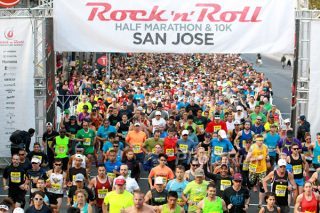
California’s fastest half marathon, the 2016 Rock ‘n’ Roll San Jose Half Marathon took place in downtown San Jose on Sunday, Oct. 2. Race weekend featured more than 17,000 runners participating in two-days of running with a 5k and Kids Races taking place on Saturday, followed by 10k and half-marathon on Sunday. Local bands performed along the streets of San Jose, joining spectators and high school cheerleading teams lining the route to motivate runners to the finish line. Upon finishing at Plaza de Cesar Chavez, participants are invited to relax and celebrate with family and friends as headliner Rouge Wave took the stage for the Toyota Rock ‘n’ Roll Marathon Series Concert. (Photos: PhotoRun.net)
RELATED: American Biwott Wins Rock ‘n’ Roll San Jose Half Marathon
Photo Gallery
1 of {count}
Back to Start
View Larger Image

2016 Rock 'n' Roll San Jose Half Marathon
View Larger Image
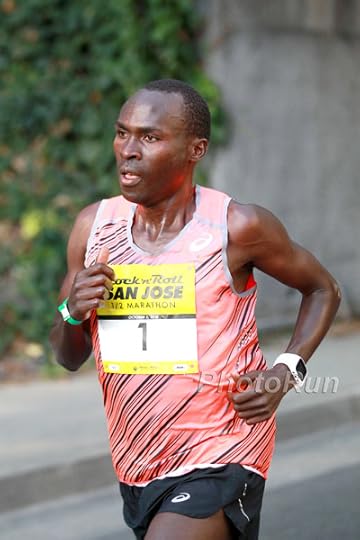
2016 Rock 'n' Roll San Jose Half Marathon
View Larger Image
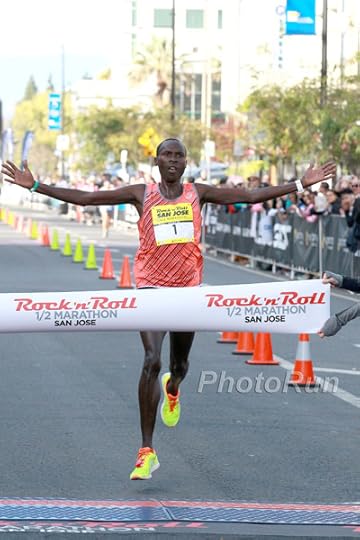
2016 Rock 'n' Roll San Jose Half Marathon
View Larger Image

2016 Rock 'n' Roll San Jose Half Marathon
View Larger Image

2016 Rock 'n' Roll San Jose Half Marathon
View Larger Image
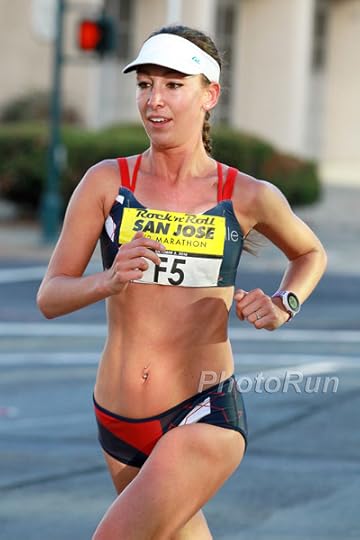
2016 Rock 'n' Roll San Jose Half Marathon
View Larger Image

2016 Rock 'n' Roll San Jose Half Marathon
View Larger Image

2016 Rock 'n' Roll San Jose Half Marathon
View Larger Image

2016 Rock 'n' Roll San Jose Half Marathon
View Larger Image

2016 Rock 'n' Roll San Jose Half Marathon
View Larger Image
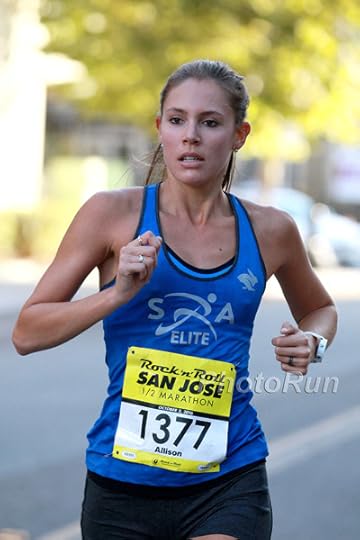
2016 Rock 'n' Roll San Jose Half Marathon
View Larger Image

2016 Rock 'n' Roll San Jose Half Marathon
View Larger Image

2016 Rock 'n' Roll San Jose Half Marathon
View Larger Image

2016 Rock 'n' Roll San Jose Half Marathon
View Larger Image

2016 Rock 'n' Roll San Jose Half Marathon
View Larger Image

2016 Rock 'n' Roll San Jose Half Marathon
View Larger Image

2016 Rock 'n' Roll San Jose Half Marathon
View Larger Image

2016 Rock 'n' Roll San Jose Half Marathon
View Larger Image

2016 Rock 'n' Roll San Jose Half Marathon
View Larger Image

2016 Rock 'n' Roll San Jose Half Marathon
View Larger Image

2016 Rock 'n' Roll San Jose Half Marathon
View Larger Image

2016 Rock 'n' Roll San Jose Half Marathon
View Larger Image

2016 Rock 'n' Roll San Jose Half Marathon
View Larger Image

2016 Rock 'n' Roll San Jose Half Marathon
Related Galleries

Photos: 2016 Rock ‘n’ Roll Lisbon Marathon EDP

Photos: Rock ‘n’ Roll Queretaro 5k

Photos: 2016 Rock ‘n’ Roll San Jose Kids Rock

Photos: 2016 Rock ‘n’ Roll San Jose 5k

More Galleries
The post Photos: 2016 Rock ‘n’ Roll San Jose Half Marathon appeared first on Competitor.com.
Ryan Hall's Blog
- Ryan Hall's profile
- 21 followers



